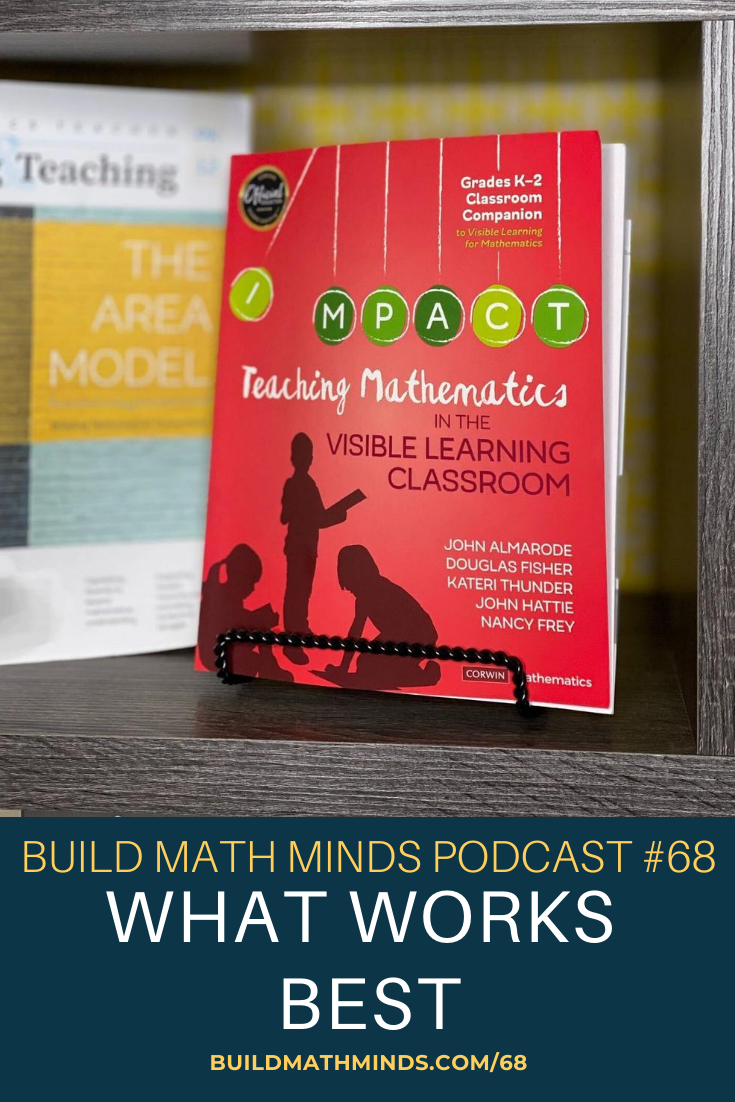Resources mentioned in this episode:
The Visible Learning series of books
Teaching Mathematics in the Visible Learning Classroom, Grades K-2 by John T. Almarode, Douglas Fisher, Kateri Thunder ,John Hattie, and Nancy Frey
Register for the FREE Build Math Minds Virtual Summit
Welcome fellow Recovering Traditionalists to Episode 68. Today we are talking about What Works Best.
We all know that we can pretty much find research to support any claim you ever want to make about what works when teaching. There’s research to say ability grouping works, there’s research to say it doesn’t. There’s research to say we should use manipulatives, there’s research to say we shouldn’t.
But when I hear that something has an effect-size of _____, it makes me give more pause to consider something.
If you aren’t familiar with effect-sizes, they come from the work of John Hattie that was published in the book Visible Thinking. But, to summarize, Hattie did a meta-analysis and combined findings from 80,000 studies to find patterns to help us inform our practice. The effect size is the size of the effect certain things have on student learning. Now just because something has a large effect size I don’t automatically start implementing it and just because something has a small effect size doesn’t mean I automatically dismiss it. But it does make me stop and consider (or re-consider) that instructional idea a lot more.
There is a whole series of books that are based on the ideas in Visible Learning. Kateri Thunder, one of the co-authors of Teaching Mathematics in the Visible Learning Classroom, Grades K-2, is actually presenting at the upcoming Build Math Minds Virtual Math Summit! Have you registered yet?? The link to register is over at buildmathminds.com/virtual-math-summit
In that book on page 3, they write:
“Our students come to our classrooms with different background knowledge, levels of readiness, and learning needs. Our goal is to unveil what works best so that your learners develop the tools needed for successful mathematics learning.
Identifying what works best draws from the key findings from Visible Learning (Hattie, 2009) and also guides the classrooms described in this book. One of those key findings is that there is no one way to teach mathematics or one best instructional strategy that works in all situations for all students, but there is compelling evidence for certain strategies and approaches that have a greater likelihood of helping students reach their learning goals. In this book, we use the effect size information that John Hattie has collected and analyzed over many years to inform how we transform the findings from the Visible Learning research into learning experiences and challenging mathematical tasks that are most likely to have the strongest influence on student learning.”
The book contains lots of great information about how to change up our teaching of mathematics to have the greatest impact on student learning. Every classroom is different, every teacher is different and so what works best for some may not work best for others, but I highly recommend getting the book to learn more and I’d also love to have you join Kateri Thunder’s session during the Build Math Minds Virtual Math Summit. It’s free to attend and you will get to hear Kateri talk about implementing Peer Tutoring, which you could probably guess, has a high effect size.
Subscribe and Review in iTunes
Hey, are you subscribed to the Build Math Minds Podcast, yet? If you’re not, make sure to do that today because I don’t want you to miss any episodes! Click here to subscribe to the podcast in iTunes.
While you’re there, don’t forget to leave a review on iTunes too. I would love to know your thoughts and how we can make sure that we give you content that you will really enjoy.
To leave a review, head over to iTunes and click on “Ratings and Reviews” and “Write a Review.” I can’t wait to hear your thoughts about the podcast.




